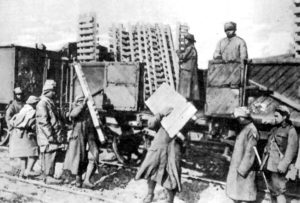Posted: April 6th, 2017 | No Comments »
In my local bookstore the other day I note that the new Robert Bickers is in stock and awaiting your contactless payment card…..it is a seriously heavy book both intellectually and in sheer weight!!

Even at the high noon of Europe’s empires China managed to be one of the handful of countries not to succumb. Invaded, humiliated and looted, China nonetheless kept its sovereignty. Robert Bickers’ major new book is the first to describe fully what has proved to be one of the modern era’s most important stories: the long, often agonising process by which the Chinese had by the end of the 20th century regained control of their own country.
Out of China uses a brilliant array of unusual, strange and vivid sources to recreate a now fantastically remote world: the corrupt, lurid modernity of pre-War Shanghai, the often tiny patches of ‘extra-territorial’ land controlled by European powers (one of which, unnoticed, had mostly toppled into a river), the entrepôts of Hong Kong and Macao, and the myriad means, through armed threats, technology and legal chicanery, by which China was kept subservient.
Today Chinese nationalism stays firmly rooted in memories of its degraded past – the quest for self-sufficiency, a determination both to assert China’s standing in the world and its outstanding territorial claims, and never to be vulnerable to renewed attack. History matters deeply to Beijing’s current rulers – and Out of China explains why.
Posted: April 5th, 2017 | 1 Comment »
I thought I’d just to take a minute to very briefly weigh in on the debate kicked off by Hilary Mantel at the Oxford Literary Festival on historical fiction. Strictly I don’t think of myself as a writer of historical fiction but more in the realms of literary non-fiction, but still – real folk, real places, real times presented in the form of a novel still applies to me I think….
Mantel was talking about historical fiction (where bibliogaphies of texts consulted are often, but far from always, included at the end of the book) –
According to The Guardian Mantel, ’rounded on her “cringing†contemporaries in historical fiction who “try to burnish their credentials by affixing a bibliographyâ€. “You have the authority of the imagination, you have legitimacy. Take it. Do not spend your life in apologetic cringing because you think you are some inferior form of historian. The trades are different but complementary,†she said.’
Now, I have been known to add a list of non-fiction, academic works at the end of my own work and to note books consulted for information in footnotes (along with newspapers, verbal interviews, exchanges of emails etc). I am not sure what other historical fiction writers would say but for me it is about acknowledging the debt to academic scholars whose work has been inspiring and/or informative. It is not a case of ‘burnishing credentials’ or lack of belief in my own writing but accepting that it comes from a number of sources – reading old newspapers, magazines and documents, my imagination sometimes and academic studies.
In fact I would consider it rude not to acknowledge this sort of inspiration – my new book City of Devils (details to follow soon) is set in Shanghai in the 1930s. It is literary non-fiction; the story of men and women in Shanghai and their lives. I discovered those stories by reading newspapers from the time, official documents and police records. But I wouldn’t have raised an authorial eyebrow in interest when reading those documents had it not been for the academic work of the great Sinologist Frederic Wakeman on Shanghai. Simple as that and should be acknowledged…
 without Wakeman there would be no City of Devils coming out this September – and I’m going to acknowledge that!
without Wakeman there would be no City of Devils coming out this September – and I’m going to acknowledge that!
Posted: April 4th, 2017 | No Comments »
well done to Nias Press (of Denmark I believe) for republishing Alfred Raquez’s 1898 In The Land of the Pagodas, edited and translated by William L. Gibson and Paul Bruthiaux. Raquez was quite a character and the book has long been overlooked….
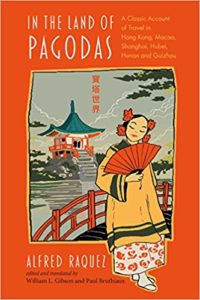
• Takes readers on a vivid tour of fin-de-siècle China in the company of a Parisian boulevardier on the run.
• A startlingly fresh voice from over 100 years ago.
• The first English translation of a long out-of-print and sorely neglected work.
China, 1898: a time of war, intrigue and growing foreign power. Onto the scene comes a Parisian fugitive with a gifted pen and a journalist’s eye. Alfred Raquez drifts from Indochina to Hong Kong, Macao and Canton before falling in with a group of shady entrepreneurs in Shanghai with interests far up the Yuan River. In short order, Raquez sets off on a rollicking voyage into the heart of the lawless Miao-country, pen and camera in hand. The result is a richly recorded adventure told from the perspective of a wandering French boulevardier. In the Land of Pagodas takes readers on a picaresque journey that is as much Moulin Rouge as it is Heart of Darkness, and in its narration reveals much about the derring-do and startling hypocrisy of the colonial enterprise. Raquez’s amazing story is continued in his second book, on his Laotian travels, again translated and edited by Bruthiaux and Gibson, and planned for publication by NIAS Press in 2017.
‘Alfred Raquez’ was the pseudonym of Joseph Gervais, a bankrupt French lawyer who fled to the Far East in the late 1890s and had access to some of the powerful players in French Indochina. He wrote prolifically about China and Indochina, took some of the earliest photographs of Laos and made the earliest field sound recordings in that land. He died under mysterious circumstances in Marseille in 1907. Confidence man, daring explorer, dashing bon vivant, proto-photojournalist and amateur ethnographer in equal parts, Raquez offers one of the more intriguing voices (not to mention mystery-filled yarns) of any commentator on the mix of ambitions and follies of of European colonial expansion into the Far East. California-native William L. Gibson is a writer, researcher and occasional sound artist based in Southeast Asia. A prolific academic author and editor, French-born Paul Bruthiaux now lives in Thailand.
Posted: March 31st, 2017 | No Comments »
for anyone who doesn’t know the story or hasn’t heard of this great documentary…
Filmmaker Robin Lung
Filmmaker Robin Lung turns detective to uncover the forgotten story of Li Ling-Ai, the un-credited female producer of KUKAN, an Academy Award-winning color documentary about World War II China that has been lost for decades.

In the late 1930s China is in dire straits. The country will collapse under Japan’s military juggernaut if it doesn’t get outside help. Chinese American firebrand Li Ling-Ai jolts Americans into action with a new medium — 16mm Kodachrome color film. She hires photojournalist Rey Scott to travel to China and capture a citizen’s perspective of the war-torn country, including the massive bombing of the wartime capital Chungking (now Chongqing). Their landmark film KUKAN screens for President Roosevelt at the White House, is called “awesome†by the New York Times, and receives one of the first Academy Awards for a feature documentary in 1942. Why have we never heard of Li Ling-Ai? And why have all copies of KUKAN disappeared? Filmmaker Robin Lung goes on a 7-year quest to find the answers.
There’s a trailer here
And details of upcoming screenings in Chicago and Los Angeles in April here…

Posted: March 30th, 2017 | 1 Comment »
The Guardian ran a story the other day, by Francesca Perry, on a new wave of architectural heritage destruction in Dalian. Sadly Dalian’s gradual architectural demolition is long running and all-encompassing (housing, shops, hotels, entire streets) not withstanding some attempts at a sort of Disneyfication of “Russian” streets and plenty of facadicide. It’s also been the case that where attempts at preservation or refurbishment have been tried they have not been well executed. The now disgraced Bo Xilai, when mayor of Dalian (1993-2000), liked (as part of his self-glorification campaign) to have it regularly reported that he was restoring the city to its former glory. The reality is that, apart from a few poorly executed projects such as Russian Street, he did no such thing and indeed quite the opposite.
First off the whole scale destructions of the 2000s – IÂ would point you to my blog post from February 2009 when I was in Dalian to witness the wholesale destruction of Harbin Jie which, as you can see, was originally a fairly grand street of European style villas. This was not simply one street but about half a dozen similar streets – a few showcase examples may remain but the cluster of excellent houses has been obliterated.
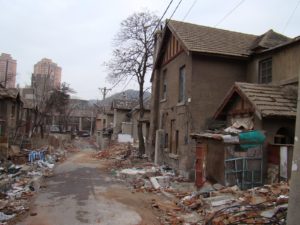 Harbin Jie coming down in early 2009
Harbin Jie coming down in early 2009
Secondly to the poor quality of preservation/refurbishment in Dalian – there are many examples of poor and shoddy preservation but here is a blog post from a visit to the city in August 2009 when there was a spate of replacing the elegant red roof tiles on many buildings (including on the show piece Zhongshan Square/Bankers Circle) with poor quality plastic imitations. This was accompanied by the almost wholesale ripping out of original Crittal (most probably manufactured at Crittal’s Shanghai factory) or iron window frames and their replacement with architecturally incorrect and vile uPVC (the tendency to replace Crittal, wood and iron window frames with uPVC is, i know, a global scourge of bad taste and poor refurbishment). How well these tiles have lasted I cannot say, but even from a distance they look horrid compared to the originals, which were easy enough to replace with similar.
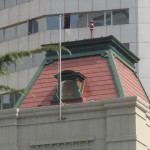 plastic tile replacements on the CITIC Building, Zhongshan Square, Dalian in 2009
plastic tile replacements on the CITIC Building, Zhongshan Square, Dalian in 2009
So while there is still a lot to fight to preserve in Dalian, we should also remember that the city has, sadly, suffered a good quarter century of destruction already.
Posted: March 29th, 2017 | No Comments »
Apologies for self-promotion….
Herewith begins a new fortnightly series I’m writing for the Literary Hub – Crime & the City – we start with Amsterdam….but, you won’t be surprised to hear, Asian cities will feature quite prominently as the months pass…..
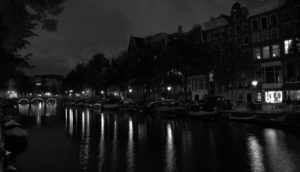
Posted: March 28th, 2017 | No Comments »
 The late Qing Dynasty Chinese diplomat Tsui Kwo Yin (Cui Guoyin) is not well remembered by China. He is seen as ineffectual at best and actually harmful to the cause of China at worst. Tsui was a senior diplomat though, representing China in major countries such as America, Japan and Peru. However, his English language skills were not deemed sufficient to really get his points across to the American media at a time when China sought to both protect its countrymen against discrimination and voice its disapproval of the Chinese Exclusion Act. He is also criticised for being bad at small talk (silly, but probably quite a useful skill for a diplomat) and a bit of an introvert. But this is a slightly different and more positive anecdote…from Juliet Nicolson’s A House Full of Daughters about her mother, grandmother (Vita Sackville West), great grandmother (the Victoria noted below) and great-great grandmother, the Spanish dancer and beauty Pepita.
The late Qing Dynasty Chinese diplomat Tsui Kwo Yin (Cui Guoyin) is not well remembered by China. He is seen as ineffectual at best and actually harmful to the cause of China at worst. Tsui was a senior diplomat though, representing China in major countries such as America, Japan and Peru. However, his English language skills were not deemed sufficient to really get his points across to the American media at a time when China sought to both protect its countrymen against discrimination and voice its disapproval of the Chinese Exclusion Act. He is also criticised for being bad at small talk (silly, but probably quite a useful skill for a diplomat) and a bit of an introvert. But this is a slightly different and more positive anecdote…from Juliet Nicolson’s A House Full of Daughters about her mother, grandmother (Vita Sackville West), great grandmother (the Victoria noted below) and great-great grandmother, the Spanish dancer and beauty Pepita.
In 1892 Victoria West (below) was married to Lionel Sackville-West. Victoria’s parentage is a tricky business (to complicated to go into fully here – I’d suggest reading A House Full of Daughters) but she had spent time in Washington DC in the 1880s when her father (also called Lionel Sackville-West – the uncle of the Lionel above and so they were first cousins, which was generally acceptable then) was British Ambassador to the USA. She was very popular, her looks and character much admired (she was reputedly proposed to at least 25 times by many famous men) and obviously also, along with her father, well-remembered.

So well-remembered that Tsui Kwo Yin sent her a wedding present from Washington to the Sackville-West family estate of Knole (in Sevenoaks, Kent). What he actually sent was a cloak of Tibetan goat. I don’t know whatever happened to that cloak (perhaps Juliet Nicolson knows?) but what a grand gift!! A nice gesture from someone rather written out of Qing-era diplomatic history now…
Here we have Minister Tsui himself, illustrated shortly after his Ambassadorship in Washington finished (1893) and himself and his retinue departing America for China….


Posted: March 27th, 2017 | No Comments »
I’ve blogged a fair bit on the Chinese Labour Corps in WW1 so perhaps some readers may be interested in this event…
Chinese Labour Corps Project Launch Event – 19th April 2017

On 19th April, 1917, after a three-month journey over land and sea, a thousand Chinese men arrived in Le Havre, France, weary and bewildered. This was the first batch of the Chinese Labour Corps, recruited by the British to provide logistical help to the Western Allies. They would be followed by several tens of thousands, mainly from Shandong Province, thus forming one of the largest labour corps involved in the Great War.
To mark this historically significant event, exactly one hundred years later on 19th April, 2017, The Meridian Society, with SOAS China Institute as host, will be holding a film screening and talks to launch our heritage project on the Chinese Labour Corps, with the support of a grant from the Heritage Lottery Fund.
The key resource is a collection of unique interviews with CLC descendants from Shandong. Their distinctive memories have been captured on camera and at this launch, guests will be able to view for the first time, a public screening of the documentary ‘Forgotten Faces of the Great War’, containing oral histories by descendants both of Chinese labourers and Western CLC officers.
Alongside the screening will be talks by eminent speakers
(Chaired by Lars Laaman SCI) including:
– Frances Wood, Author of Author of ‘Betrayed Ally’, former Curator of Chinese Collections at the British Library and Research Associate at SOAS China Institute;
– Dominiek Dendooven, Curator at In Flanders Fields Museum;
– Andrew Fetherston, Archivist at Commonwealth War Graves Commission and
– Zhang Yan The Chinese University of Hong Kong.
A small display of items, including photos, documents and memorabilia, will be on show.
We will also be announcing details of the Society’s year-long series of activities to commemorate the CLC.
The event will be brought to a close by a Ceremony for the Departed conducted by Representatives of the London Fo Guang Shan Temple.
We hope you will be able to join us for this special event.
Please reserve your place no later than Wednesday 22nd March by replying to The Meridian Society at chineselabourcorps@gmail.com
Date: Wednesday, 19th April Time: 2.00-6.00pm
Venue: Djam Lecture Theatre (DLT)
SOAS University of London, Thornhaugh Street, Russell Square, London WC1H 0XG Entry: Free, but places must be booked in advance
